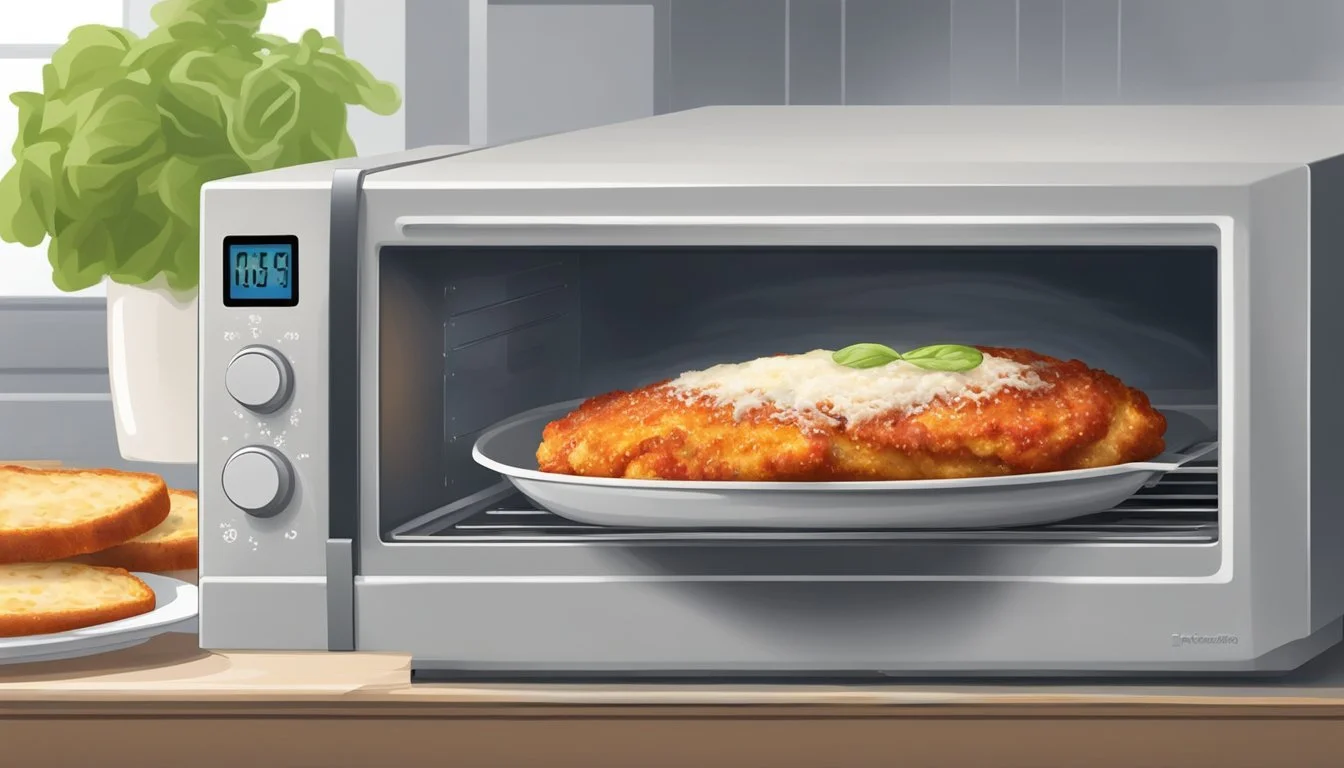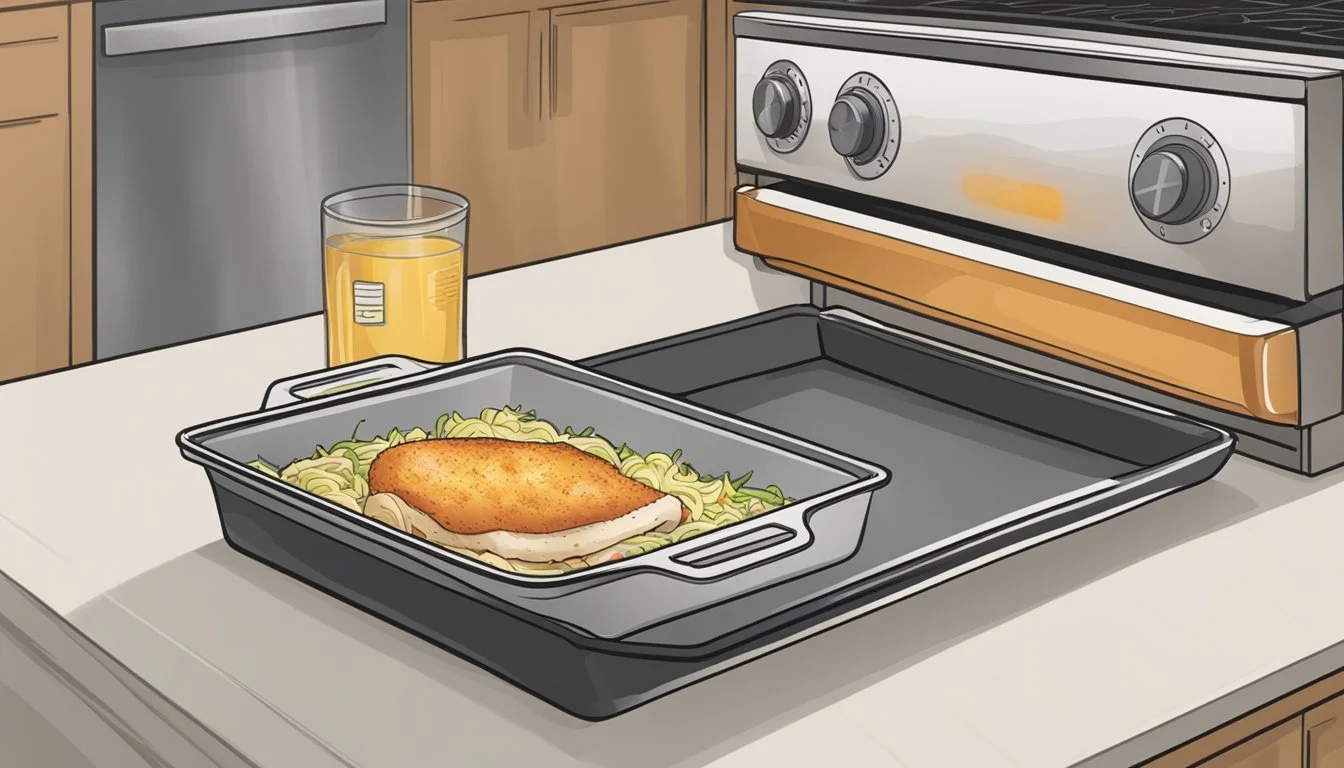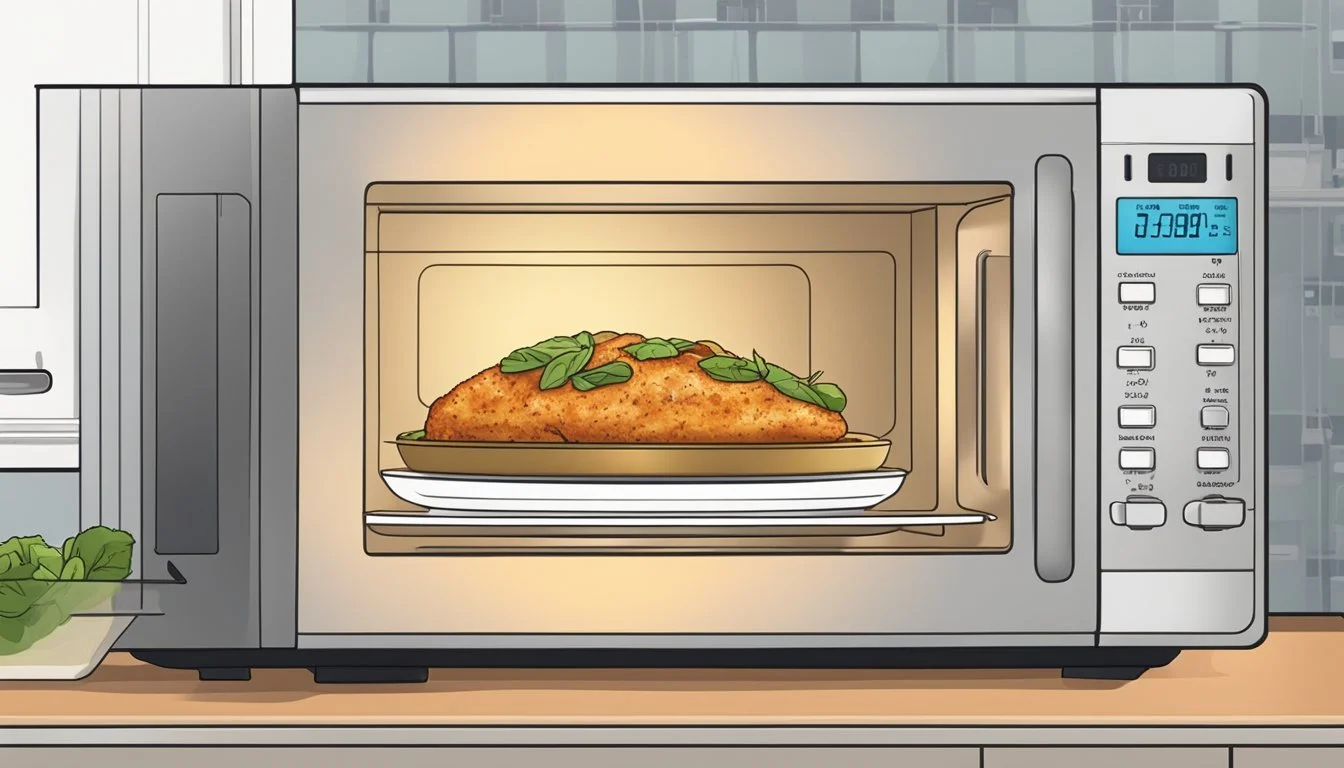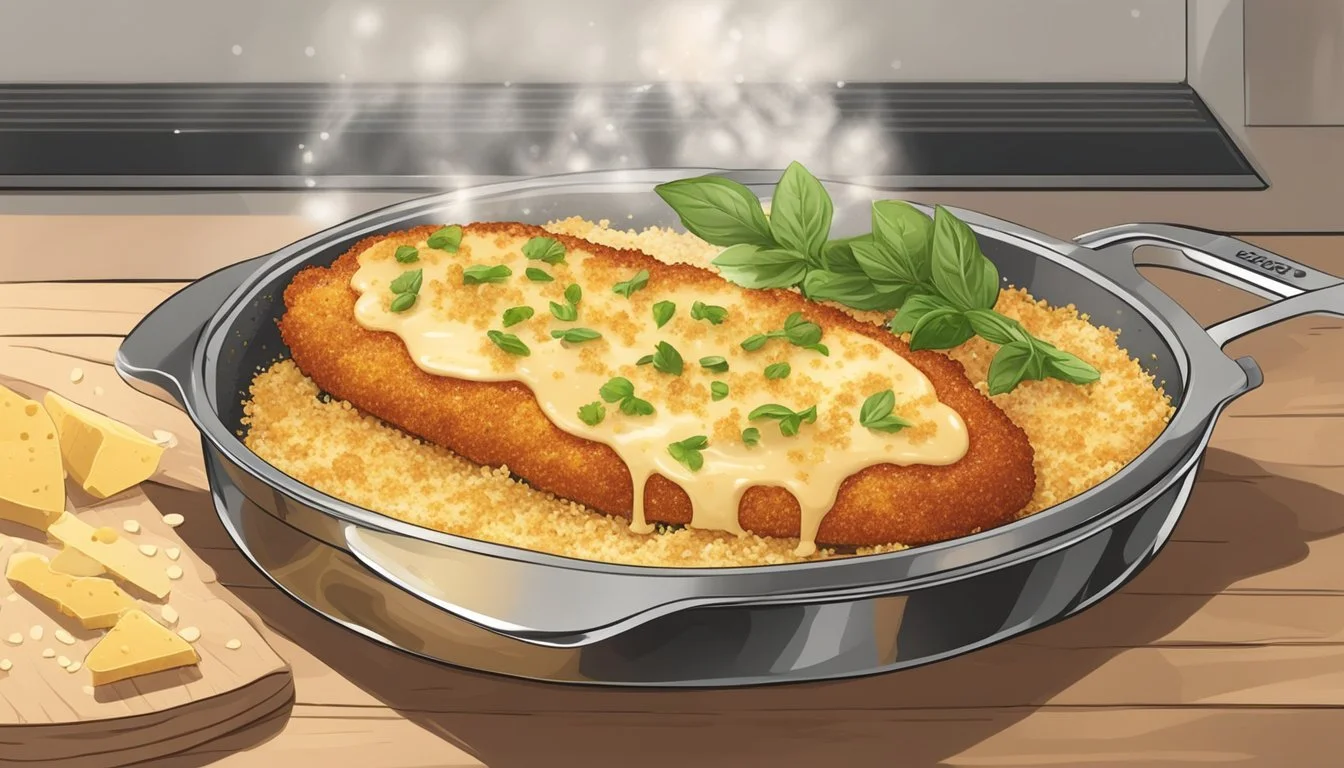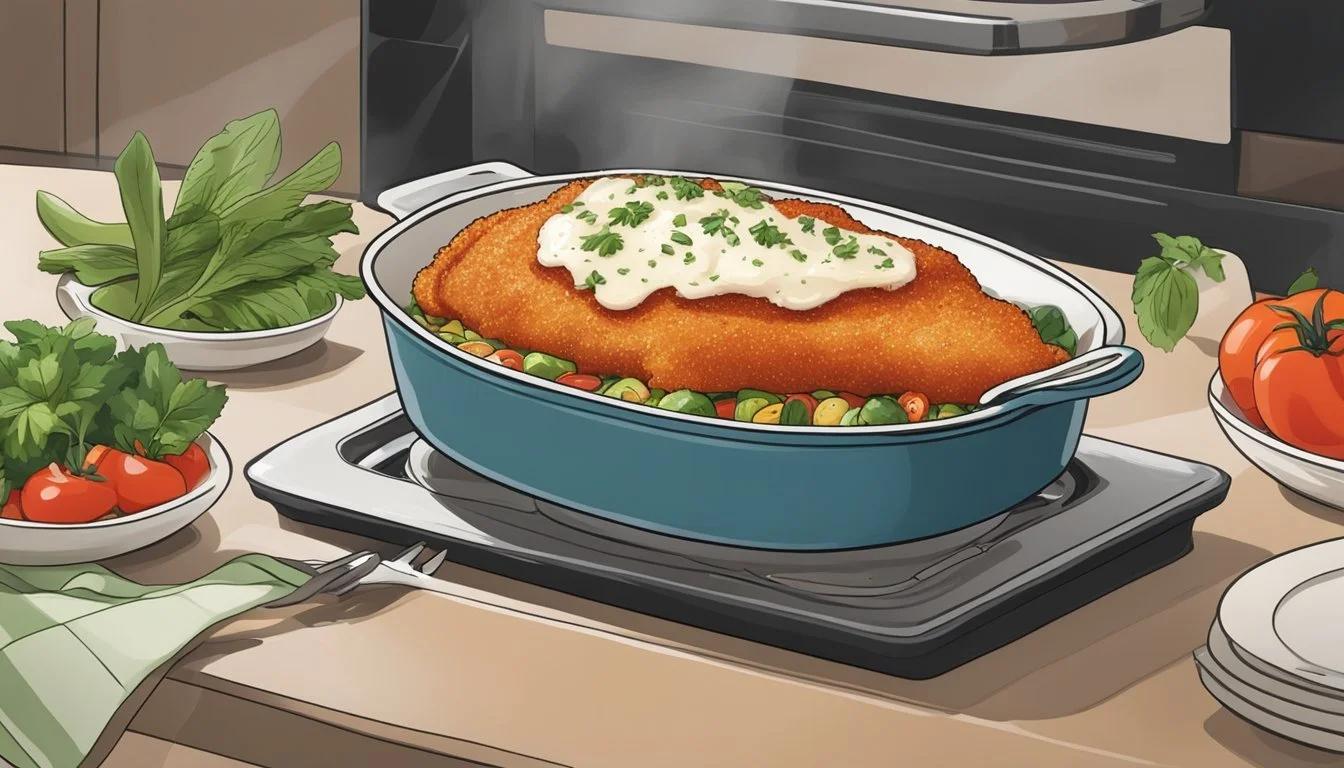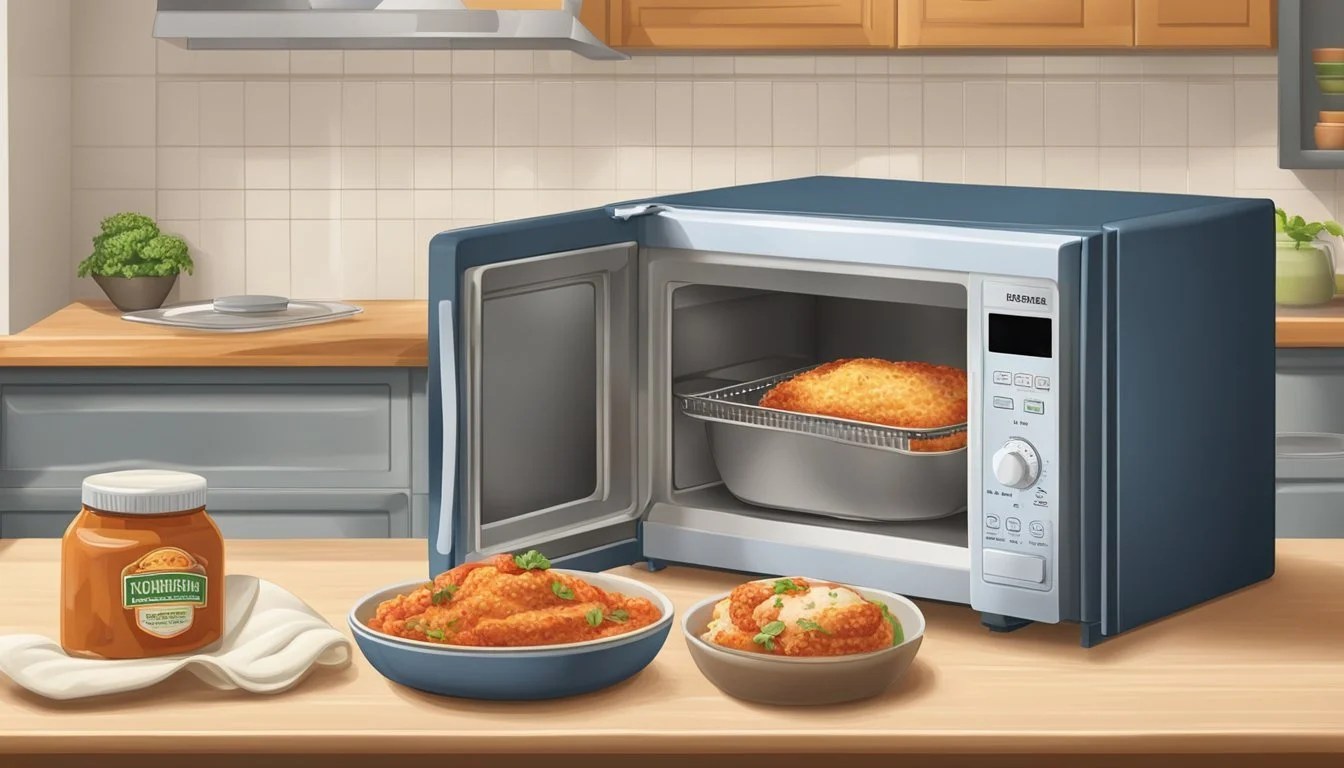How to Reheat Gluten-Free Chicken Parmesan
Step-by-Step Guide
Ever wondered the best way to reheat your delicious gluten-free chicken Parmesan without compromising its texture and flavor? Preheat your oven to 350°F (175°C) and bake the chicken Parmesan for about 15-20 minutes until the cheese is melted and the chicken is heated through. This method ensures your dish retains its crunchy exterior and gooey cheese topping, making it taste as good as the first time.
Microwaving can be quick, but it often results in a soggy crust which is far from ideal. For better results, use an oven or a toaster oven. This method will help maintain the crispiness of the gluten-free breading that makes this dish a favorite.
Another great way to reheat is using a skillet. Preheat a lightly oiled skillet over medium heat and reheat your chicken Parmesan for several minutes on each side. This technique not only heats your dish evenly but also keeps the crust crisp and the inside juicy.
Importance of Proper Reheating
Properly reheating gluten-free chicken Parmesan ensures the dish remains tender, juicy, and flavorful.
Reheating methods can significantly affect the texture of chicken Parmesan. Incorrect reheating can lead to a dry, tough dish, whereas correct methods preserve its tender and juicy qualities. This is especially important for gluten-free versions, which rely on specific ingredients to maintain their consistency.
Food safety is another critical aspect. Reheating effectively can kill any bacteria that may have developed. It is essential to reheat the chicken Parmesan to an internal temperature of at least 165°F (74°C) to ensure it is safe to eat.
Keeping track of the internal temperature ensures the chicken is reheated evenly. Using tools such as a meat thermometer can help verify that the proper temperature is reached without overcooking, maintaining the dish's flavor.
Lastly, using methods like the oven, air fryer, or stovetop with controlled heat settings aids in restoring the dish's original taste and texture, making each bite as enjoyable as the first.
Pre-Reheating Considerations
Reheating gluten-free chicken Parmesan involves ensuring food safety and maximizing taste. The key considerations include assessing the quality of the leftovers and allowing them to reach room temperature before reheating.
Assessing the Leftovers
Before reheating, evaluate the quality and safety of the leftovers. Check the storage—the chicken Parmesan should be kept in an airtight container to prevent contamination and drying out. Look for signs of spoilage such as an off smell, discoloration, or mold.
Date the container when storing; leftovers should ideally be consumed within 3-4 days to ensure freshness. Inspect the chicken and cheese carefully; gluten-free ingredients can deteriorate faster due to the lack of preservatives.
Plan for portion control if reheating individual servings. Smaller portions will heat more evenly, decreasing the risk of foodborne illness.
Bringing to Room Temperature
Allow the gluten-free chicken Parmesan to come to room temperature before reheating. This can help in achieving even heating, reducing the chances of cold spots or overcooked edges.
Place the chicken on the counter for about 30 minutes. This time frame is enough to take the chill off without spending too much time outside the fridge. Use a food thermometer to ensure the dish reaches an internal temperature of at least 165°F (73.9°C).
Cover the dish loosely with foil if it sits out longer, to keep out contaminants. Be mindful of the overall time outside refrigeration to maintain safety.
Choosing the Right Reheating Method
Reheating gluten-free chicken Parmesan requires selecting the right method to ensure it remains crispy and delicious. Each reheating technique—oven, microwave, and air fryer—offers distinct advantages.
Oven Reheating
Oven reheating is an ideal method to preserve the crispiness and ensure the chicken Parmesan heats evenly. Preheat the oven to 350°F (175°C). Place the chicken Parmesan on a baking sheet or in an oven-safe dish. Cover it with aluminum foil to retain moisture.
Bake for 15-20 minutes until the cheese melts and the chicken is heated through. For an extra crispy finish, remove the aluminum foil for the last few minutes of baking. This method takes longer but results in a golden brown crust.
Microwave Reheating
Microwave reheating is the fastest way to warm up your dish, though it may not maintain the crispy texture. Place the chicken Parmesan on a microwave-safe plate. Cover it with a damp paper towel to prevent it from drying out.
Heat on medium power for 1-2 minutes and check the temperature. Continue heating in 30-second intervals until fully heated. This method is convenient but the texture might be less crispy compared to other methods.
Air Fryer Reheating
Using an air fryer is excellent for restoring the crispiness of gluten-free chicken Parmesan. Preheat the air fryer to 350°F (175°C). Place the chicken in the air fryer basket, ensuring it is not overcrowded.
Heat for 5-7 minutes until the cheese is melted and the chicken reaches the desired temperature. The air fryer provides a quick and efficient way to achieve a crispy, golden brown crust.
Each method has its benefits, providing flexibility based on time constraints and desired texture.
Step-by-Step Reheating Instructions
Reheating gluten-free chicken Parmesan requires specific techniques to ensure it remains delicious and safe to eat. Follow these methods to heat it up in the oven, microwave, or air fryer.
Oven Method
To reheat gluten-free chicken Parmesan in the oven, preheat to 350°F (175°C). Place the chicken on a baking sheet or in an oven-safe dish. Cover the dish with aluminum foil to prevent drying out. Bake for 15-20 minutes until the cheese melts and the internal temperature reaches 165°F (74°C). Remove the foil in the last 5 minutes to crisp the breadcrumb topping.
Pro Tip: Adding a small amount of marinara sauce before baking can enhance the flavor and prevent dryness.
Microwave Tips
For a quicker option, the microwave can be used. Place the chicken on a microwave-safe plate. Add a splash of water or broth to the plate to keep the chicken moist. Cover the dish with a microwave-safe lid or plate. Microwave on medium power in 1-minute intervals, checking the temperature after each interval. Aim for an internal temperature of 165°F.
Pro Tip: Avoid overcooking by using shorter intervals and checking frequently.
Air Fryer Directions
An air fryer can also be an effective way to reheat gluten-free chicken Parmesan. Preheat the air fryer to 350°F (175°C). Place the chicken in the air fryer basket in a single layer. Heat for around 5-7 minutes, checking halfway through. The cheese should be melted and the internal temperature should be 165°F.
Pro Tip: For extra crispiness, lightly spray the chicken with cooking oil before reheating.
Finishing Touches After Reheating
After reheating your gluten-free chicken Parmesan, consider incorporating fresh ingredients and techniques to enhance its flavor and texture. These steps ensure each bite is as delightful as the first time it was cooked.
Adding Freshness
Sprinkle fresh parsley or basil over the reheated chicken Parmesan. These herbs add a burst of color and a subtle aromatic touch, elevating the dish's overall appeal.
Next, grated mozzarella cheese can be sprinkled on top. Place the dish back under the broiler for a couple of minutes to melt the cheese for an appealing, golden finish.
Freshly grated Parmesan cheese also works well. Serve with a side of warmed marinara sauce for added flavor and moisture.
Ensuring Moisture
To avoid dryness, a dollop of extra marinara sauce can be spread evenly over the chicken. This keeps the meat moist and adds a rich, tangy flavor.
Another method is to drizzle a little olive oil on the chicken before reheating. This not only adds moisture but also enhances the dish's depth of flavor.
One more practical tip is to cover the chicken with foil during reheating, especially in the oven. This helps retain moisture, preventing the chicken from becoming dry.
Alternative Serving Suggestions
Creating a complementary meal to serve alongside gluten-free chicken parmesan enhances the dining experience. From pairing it with suitable sides to ensuring the entire meal remains gluten-free, there are multiple options to consider.
Pairing with Sides
When choosing sides for gluten-free chicken parmesan, pasta can be a great option. Gluten-free pasta varieties such as those made from rice, corn, or quinoa work well. They cook similarly to traditional pasta and pair nicely with the rich sauce and cheese of the chicken parmesan.
For a low-carb alternative, zucchini noodles offer a healthier option. These noodles can be quickly sautéed in olive oil and seasoned with a bit of salt and pepper.
Including a side salad is always a good idea. A fresh green salad with leafy greens, cherry tomatoes, cucumbers, and a gluten-free vinaigrette adds a refreshing contrast to the heartiness of the main dish.
Roasted asparagus is another excellent choice. Lightly seasoned with olive oil, salt, and pepper, roasting brings out its natural sweetness and crispiness.
Making a Gluten-Free Meal
It's essential to ensure that all components of the meal remain gluten-free. This means using gluten-free pasta if pairing with traditional noodles. Double-check labels on sauces and dressings to confirm they do not contain gluten.
Zucchini noodles are naturally gluten-free and provide a nutritious base. Spiralize fresh zucchini or buy pre-spiralized noodles for convenience.
When serving a salad, choose dressings labeled gluten-free. Many store-bought dressings contain gluten, so it is safer to opt for homemade vinaigrettes using olive oil, vinegar, and herbs.
For those who prefer a roasted vegetable side, asparagus is a reliable option. It's naturally gluten-free, quick to prepare, and pairs well with the flavors of chicken parmesan. Cook it with minimal seasoning to keep the focus on the dish itself.
These suggestions ensure a well-balanced, gluten-free meal that complements the flavors and textures of the chicken parmesan seamlessly.
Safety and Storage Tips
Proper storage and handling of gluten-free chicken Parmesan ensure that it stays safe to eat and maintains its delicious taste.
Storing Leftovers
Cool the Chicken Parmesan: Before storing, allow the cooked chicken Parmesan to cool to room temperature to prevent condensation, which can lead to sogginess and bacterial growth.
Use Airtight Containers: Store the leftovers in airtight containers to keep out moisture and contaminants. Glass or plastic containers with secure lids work well.
Refrigeration: Place the containers in the refrigerator within two hours of cooking. Keeping the chicken Parmesan at a temperature below 40°F (4°C) helps prevent the growth of harmful bacteria.
Shelf Life: Consume refrigerated leftovers within three to four days to ensure freshness and safety.
Freezing and Thawing
Preparations for Freezing: Before freezing, ensure the chicken Parmesan is completely cooled. Cut into individual portions if needed for convenient reheating later.
Proper Packaging: Wrap the chicken Parmesan tightly in plastic wrap or aluminum foil, then place it in a freezer-safe bag or container to protect against freezer burn.
Freezing Time: Gluten-free chicken Parmesan can be frozen for up to three months. Label the packaging with the freezing date to keep track.
Thawing: Thaw frozen chicken Parmesan in the refrigerator overnight. Avoid thawing at room temperature to minimize the risk of bacteria growth.
Reheating: Once thawed, reheat in the oven at 350°F (175°C) until the cheese is melted and the chicken reaches an internal temperature of 165°F (74°C). Avoid microwaving as it may cause uneven heating.
Nutritional Information
Understanding the nutritional content of gluten-free chicken Parmesan can help you make informed dietary decisions.
Calories: Between 300-400 per serving, largely depending on specific ingredients and portion sizes.
Protein: A typical serving contains around 30 grams. Chicken breast is a good source of lean protein.
Fat:
Total Fat: Approximately 15-20 grams.
Saturated Fat: Around 5-6 grams.
Unsaturated Fat: Mainly from the use of olive or vegetable oil.
Trans Fat: Minimal, if any, especially when using fresh ingredients.
Carbohydrates: Typically ranges from 30-45 grams. This comes from the breading and any accompanying pasta.
Fiber: Usually 2-4 grams. Using whole grain or high-fiber gluten-free breadcrumbs can increase this amount.
Sugar: Minimal, usually less than 4 grams. Most sugar content comes from marinara sauce.
Cholesterol: About 100-120 milligrams, primarily from the chicken and egg wash.
Sodium: Can vary widely from 700-1000 milligrams, dependent on seasoning and sauce.
Incorporating these details into meal planning can help maintain a balanced diet while enjoying gluten-free chicken Parmesan.


